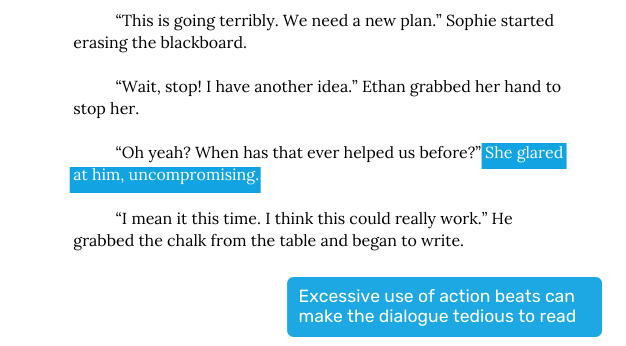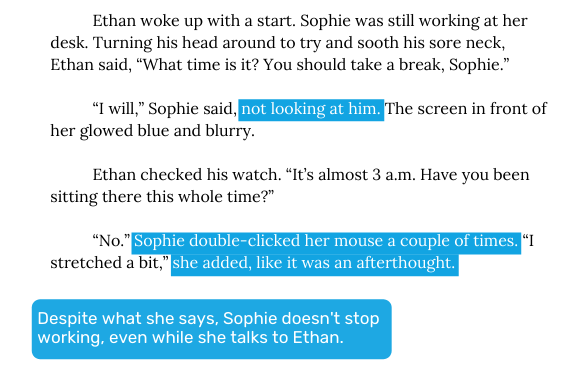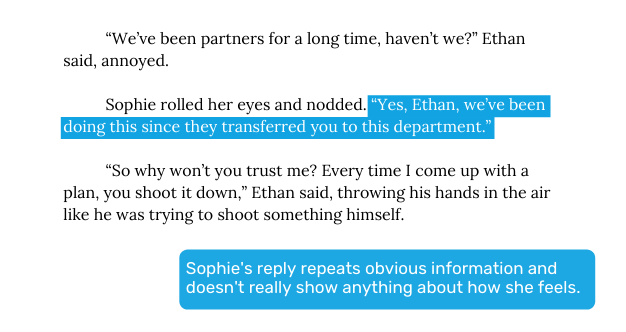Guides • Perfecting your Craft
Last updated on Sep 21, 2023
How to Write Fabulous Dialogue [9 Tips + Examples]
This post is written by author, editor, and bestselling ghostwriter Tom Bromley. He is the instructor of Reedsy's 101-day course, How to Write a Novel.
Good dialogue isn’t about quippy lines and dramatic pauses.
Good dialogue is about propelling the story forward, pulling the reader along, and fleshing out characters and their dynamics in front of readers. Well-written dialogue can take your story to a new level — you just have to unlock it.
In this article, I’ll break down the major steps of writing great dialogue, and provide exercises for you to practice your own dialogue on.
Here's how to write great dialogue in 9 steps:
👀
Which dialogue tag are YOU?
Find out in just a minute.
1. Use quotation marks to signal speech
Alfred Hitchcock once said, “Drama is life with all the boring bits cut out.”
Similarly, I could say that good dialogue in a novel is a real conversation without all the fluff — and with quotation marks.
Imagine, for instance, if every scene with dialogue in your novel started out with:
'Hey, buddy! How are you doing?"
“Great! How are you?""
'Great! Long time no see! Parking was a nightmare, wasn’t it?"
Firstly, from a technical perspective, the quotation marks are inconsistent and incorrectly formatted. To learn about the mechanics of your dialogue and how to format it, we also wrote this full post on the topic that I recommend reading.
Secondly, from a novel perspective, such lines don’t add anything to the story. And finally, from a reading perspective, your readers will not want to sit through this over and over again. Readers are smart: they can infer that all these civilities occur. Which means that you can skip the small talk (unless it’s important to the story) to get to the heart of the dialogue from the get-go.
For a more tangible example of this technique, check out the dialogue-driven opening to Barbara Kingsolver's novel, Unsheltered.
2. Pace dialogue lines by three
Screenwriter Cynthia Whitcomb once proposed an idea called the “Three-Beat Rule.” What this recommends, essentially, is to introduce a maximum of three dialogue “beats” (the short phrases in speech you can say without pausing for breath) at a time. Only after these three dialogue beats should you insert a dialogue tag, action beat, or another character’s speech.
Here’s an example from Jane Gardam’s short story, “Dangers”, in which the boy Jake is shooting an imaginary gun at his grandmother:

In theory, this sounds simple enough. In practice, however, it’s a bit more complicated than that, simply because dialogue conventions continue to change over time. There’s no way to condense “good dialogue” into a formula of three this, or two that. But if you’re just starting out and need a strict rule to help you along, then the Three-Beat Rule is a good place to begin experimenting.

FREE COURSE
How to Write Believable Dialogue
Master the art of dialogue in 10 five-minute lessons.
3. Use action beats
Let’s take a look at another kind of “beats” now — action beats.
Action beats are the descriptions of the expressions, movements, or even internal thoughts that accompany the speaker’s words. They’re always included in the same paragraph as the dialogue, so as to indicate that the person acting is also the person speaking.
On a technical level, action beats keep your writing varied, manage the pace of a dialogue-heavy scene, and break up the long list of lines ending in ‘he said’ or ‘she said’.
But on a character level, action beats are even more important because they can go a level deeper than dialogue and illustrate a character’s body language.
When we communicate, dialogue only forms a half of how we get across what we want to say. Body language is that missing half — which is why action beats are so important in visualizing a conversation, and can help you “show” rather than “tell” in writing.
Here’s a quick exercise to practice thinking about body language in the context of dialogue: imagine a short scene, where you are witnessing a conversation between two people from the opposite side of a restaurant or café. Because it’s noisy and you can’t hear what they are saying, describe the conversation through the use of body language only.
Remember, at the end of the day, action beats and spoken dialogue are partners in crime. These beats are a commonly used technique so you can find plenty of examples — here’s one from Never Let Me Go by Kazuo Ishiguro.
4. Use ‘said’ as a dialogue tag
If there’s one golden rule in writing dialogue, it’s this: ‘said’ is your friend.
Yes, ‘said’ is nothing new. Yes, ‘said’ is used by all other authors out there already. But you know what? There’s a reason why ‘said’ is the king of dialogue tags: it works.
Pro-tip: While we cannot stress enough the importance of "said," sometimes you do need another dialogue tag. Download this free cheatsheet of 270+ other words for said to get yourself covered!

FREE RESOURCE
Get our Dialogue Tag Cheatsheet
Upgrade your dialogue with our list of 270 alternatives to “said.”
The thinking goes that ‘said’ is so unpretentious, so unassuming that it focuses readers’ attention on what’s most important on the page: the dialogue itself. As writer Elmore Leonard puts it:
“Never use a verb other than ‘said’ to carry dialogue. The line of dialogue belongs to the character; the verb is the writer sticking his nose in. But ‘said’ is far less intrusive than ‘grumbled,’ ‘gasped,’ ‘cautioned,’ ‘lied.’”
It might be tempting at times to turn towards other words for ‘said’ such as ‘exclaimed,’ or ‘declared,’ but my general rule of thumb is that in 90% of scenarios, ‘said’ is going to be the most effective dialogue tag for you to use while writing dialogue.
5. Write scene-based dialogue
So now that we have several guidelines in place, this is a good spot to pause, reflect, and say that there’s no wrong or right way to write dialogue. It depends on the demands of the scene, the characters, and the story. Great dialogue isn’t about following this or that rule — but rather learning what technique to use when.
If you stick to one rule the whole time — i.e. if you only use ‘said,’ or you finish every dialogue line with an action beat — you’ll wear out readers. Let’s see how unnaturally it plays out in the example below with Sophie and Ethan:

All of which is to say: don’t be afraid to make exceptions to the rule if the scene asks for it. The key is to know when to switch up your dialogue structure or use of dialogue tags or action beats throughout a scene — and by extension, throughout your book.
🎵
Tell us about your book, and we'll give you a writing playlist
It'll only take a minute!
6. Model any talk on real life
Dialogue isn’t always about writing grammatically perfect prose. The way a person speaks reflects the way a person is — and not all people are straight-A honor students who speak in impeccable English. In real life, the way people talk is fragmented, and punctuated by pauses.
That’s something that you should also keep in mind when you’re aiming to write authentic dialogue.
It can be tempting to think to yourself, “Oh, I’ll try and slip in some exposition into my dialogue here to reveal important background information.” But if that results in an info-dump such as this — “I’m just going to the well, Mother — the well that my brother, your son, tragically fell down five years ago” — then you’ll probably want to take a step back and find a more organic, timely, and digestible way to incorporate that into your story.
For an example of how to do exposition-within-dialogue right while keeping the dialogue real to life, look to The Godfather, where readers get their first look at the Corleones through Michael's introduction of his family to his girlfriend.
Kay Adams is Michael’s date at his sister’s wedding in this scene. Her interest in his family is natural enough that the expository conversation doesn’t feel shoehorned in.
7. Differentiate character voices
A distinctive voice for each character is perhaps the most important element to get right in dialogue. Just as no one person in the world talks the same as each other, no one person in your book should also talk similarly.
To get this part of writing dialogue down pat, you need to start out by knowing your characters inside out. How does your character talk? Do they come with verbal quirks? Non-verbal quirks?
Jay Gatsby’s “old sport,” for example, gives him a distinctive, recognizable voice. It stands out because no one else has something as memorable about their speech. But more than that, it reveals something valuable about Gatsby’s character: he’s trying to impersonates a gentleman in his speech and lifestyle.
Likewise, think carefully about your character’s voice, and use catchphrases and character quirks when they can say something about your character.
🖊️
Which famous author do you write like?
Find out which literary luminary is your stylistic soulmate. Takes one minute!
8. "Show, don't tell" information in conversation
“Show, don’t tell” is one of the most oft-repeated rules in writing, and a conversation on the page can be a gold mine for “showing.”
Authors can use action beats and descriptions to provide clues for readers to read between the lines. Let’s revisit Sophie and Ethan in this example:

While Sophie claims she hasn’t been obsessing over this project all night, the actions in between her words indicate there’s nothing on her mind but work. The result is that you show, through the action beats vs. the dialogue, Sophie being hardworking—rather than telling it.

FREE COURSE
Show, Don't Tell
Master the golden rule of writing in 10 five-minute lessons.
9. Delete superfluous words
As always when it comes to writing a novel: all roads lead back to The Edit, and the dialogue you’ve written is no exception.
So while you’re editing your novel at the end, you may find that a “less is more” mentality will be helpful. Remember to cut out the unnecessary bits of dialogue, so that you can focus on making sure the dialogue you do keep matters. Good writing is intentional and purposeful, always striving to keep the story going and readers engaged. The importance lies in quality rather than quantity.
One point I haven’t addressed yet is repetition. If used well (i.e. with clear intention), repetition is a literary device that can help you build motifs in your writing. But when you find yourself repeating information in your dialogue, it might be a good time to revise your work.
For instance, here’s a scene with Sophie and Ethan later on in the story:

As I’ve mentioned before, good dialogue shows character — and dialogue itself is a playground where character dynamics play out. If you write and edit your dialogue with this in mind, then your dialogue will be sharper, cleaner, and more organic.
I know that writing dialogue can be intimidating, especially if you don’t have much experience with it. But that should never keep you from including it in your work! Just remember that the more you practice — especially with the help of these tips — the better you’ll get.
And once you’re confident with the conversational content you can conjure up, follow along to the next part of our guide to see how you can punctuate and format your dialogue flawlessly.
 Tom Bromley is an author, editor, ghostwriter, and creative writing tutor. He is Reedsy's Head of Learning and the creator of their 101-day How To Write A Novel course. He has written and co-written a dozen books under his own name and ghostwritten fifteen more, including prize-winners and international bestsellers.
Tom Bromley is an author, editor, ghostwriter, and creative writing tutor. He is Reedsy's Head of Learning and the creator of their 101-day How To Write A Novel course. He has written and co-written a dozen books under his own name and ghostwritten fifteen more, including prize-winners and international bestsellers.
As an editor and publisher, Tom has worked on several hundred titles, again including many prize-winners and international bestsellers.



